 Virgil Exner – Visioneer: The official biography of Virgil M. Exner, designer extraordinaire
Virgil Exner – Visioneer: The official biography of Virgil M. Exner, designer extraordinaire
By Peter Grist
Veloce Publishing Limited
Parkway Farm Business Park
Middle Farm Way Poundbury
Dorchester DT1 3AR England
Telephone – +44 (0)1305 260068
Facsimile – +44 (0)1305 250479
E-mail – info@veloce.co.uk
25×20.7cm • 176 pages
ISBN: 978-1-845848-63-7
$39 plus shipping
Order here
Review by Brandes Elitch
“I worked for those guys (Harley Earl, Bill Mitchell, and Elwood Engle), but Ex was unique, he was an artist who loved cars, but the others were sons of bitches that loved cars. They were all tough bozos that drove their designers really hard, but Ex was a great guy to work for.” – Dana Waterman
“His relationship with you was like a colleague, not like you were talking to a Vice President; it was two designers getting together and that’s a very unique relationship to have. He would talk design with you and wouldn’t put you down or put pressure on you…He had a great deal of respect for his designers but he was a perfectionist and he wanted that control, but he was the most creative designer I ever worked with.” – Bill Robinson
“He had an intuitive sense of body form. He was concerned primarily with the side, the silhouette, proportion, and mass. He was truly the father of re-proportioning the car and the shape of the automobile. He was a visionary.” – Bill Brownlie
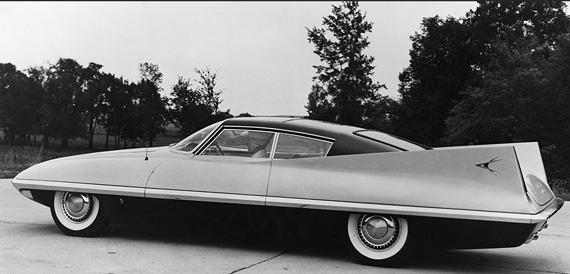
The 1957 Chrysler Dart. Savonuzzi tested it in the largest wind tunnel in Europe as a continuation of previous aerodynamic work done with the Ghia Gilda. The rear window retracted into the lower roof.
As author Peter Grist states in the conclusion of his book, Exner lived in a time when one man could be responsible for the style of an entire range of cars. In the fifties and sixties, designers could be bold and charismatic and exert control over the entire design process, as he did with the Studebaker Champion, the Italian bodied “Idea Cars” from Luigi Segre, Giovanni Savonuzzi, and Felice Mario Boano at Ghia, and the spectacular “Forward Look” production cars. Here, Grist has written the “official biography”, and it is a compelling story for anyone interested in this period of automobile design. Exner was only 26 years old when Harley Earl made him the head of the Pontiac division design studio in 1935, and he worked continuously up until his untimely death in 1973.
VeloceToday readers will undoubtedly be most interested in the collaboration with Carrozzeria Ghia, which started in 1950 and continued until 1962, the last projects being the Plymouth XNR and Asimmetrica, the Dodge FliteWing, and the final project, the 1961 Turboflite. Grist adds, “The relationship between Segre and Ex was the keystone to the success of the Chrysler-Ghia partnership, which contributed to the sharing of ideas and designs that traveled in both directions across the Atlantic, creating cars that were neither American nor Italian in design or execution, but something new and exciting…In the 1950’s the Chrysler-Ghias were unique.” In 1961, Exner did the restyling of the Dual-Ghia, the 1962 Ghia L6.4.
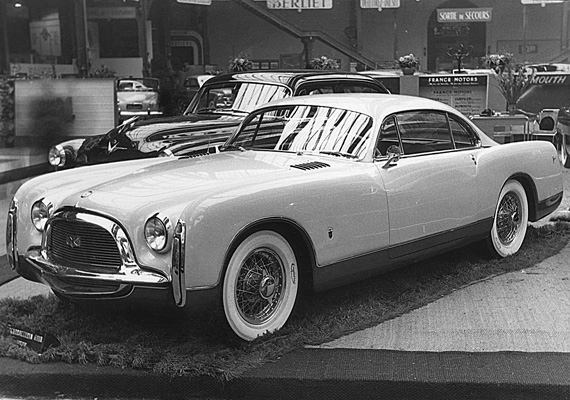
1952 Chrysler Styling Special, at its debut at the Paris Auto Show. This photo shows its .original paint scheme for the show. This was a fully engineered car that was completely functional.
This book was first published in 2007. Grist was fortunate indeed because Virgil Exner, Junior had written extensively about his father, including his own mini-biography, as well as an extensive interview in the Online Imperial Club archives. Junior had a successful career himself as an automobile stylist which started when he won an award in the 1946 Fisher Body Craftsman Guild when he was thirteen and culminated in a 21 year career in the styling section at Ford. Junior was as enthusiastic about cars as his father, and they even worked together as a team from 1962-1967 in their own styling consulting firm. Junior is an unimpeachable source of personal knowledge and involvement in all of the projects that his father did and he has a sharp memory too. In some respect, this is his book too.
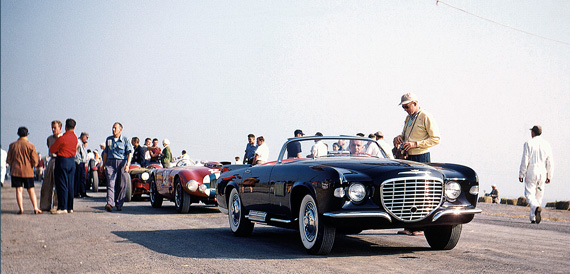
Exner behind the wheel of the 1955 Falcon, his answer to the Corvette and early T-bird. It was hemi-powered, with unit construction and a platform frame. Three were built.
Upon hearing that it was being written, I was excited to get a copy. When I did, I tracked down Junior during the Monterey Historics so I could get his autograph on my copy. This book is indeed a very complete story, and there is a lot to tell, from the early days at GM, to working for Raymond Loewy at Studebaker, to starting the styling section at Chrysler, to extensive consulting on both car and boat design, and finally, doing the Renwal Revival models, and even acquiring the very last Bugatti chassis which had never been bodied and constructing a beautiful modern interpretation for it. It is a very full life indeed.
I must admit that I am a biased reviewer, as I own 4 Exner-era cars, including a recent acquisition which took many years to find: a 1962 Plymouth Savoy coupe, which I am using to construct a 413 Max Wedge replica (only 23 original cars are known to exist today). This car dominated the A/FX class in 1962 at NHRA.
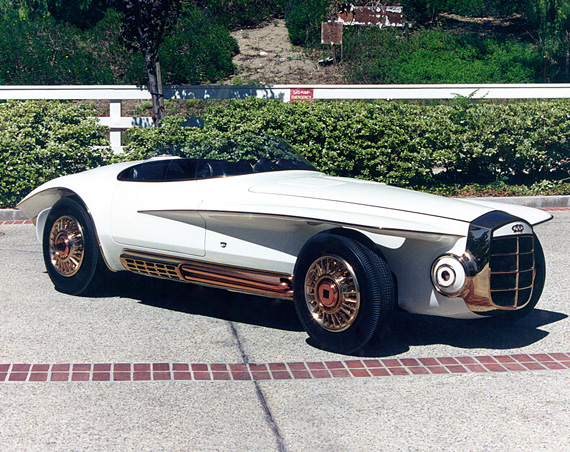
The Mercer Cobra from 1964, built on a lengthened Ford Cobra chassis by Italian carozzeria Sibona-Bassano. It was built for the Copper Development Association and so many parts were made of copper or used copper accents.
Of course, design is a very personal subject. As my artist friend Francois de la Cloche says, “A chacun son mauvais gout!” (To each his bad taste). Most people are more familiar with the offerings from G.M. and Ford, since they had a much larger market share and frankly sold a lot more cars than Chrysler. Personally, I prefer the designs which came from Exner’s studio to those of Ford and GM during the period 1955-1962. One of the most interesting things is the contrast between how he managed his styling studio and how Harley Earl at GM and George Walker at Ford managed their own studios. Of the three, Exner was the only one who could draw cars. Earl has been the beneficiary of an enormous and apparently self-perpetuating publicity machine that says he “invented the styling studio.” A careful reading of Alfred Sloan’s autobiography, My Years With General Motors, proves otherwise. Every idea, concept, plan, and styling strategy emanated from Sloan’s genius. By the 1950’s, G.M. was the largest industrial corporation in the world, and had a fifty percent market share in the country! As the person responsible for the work of the styling studios in the 5 car divisions, Earl was more of a Chief Administrative Officer than a stylist. This is not to minimize that job because, after all, there were 1100 people in this business unit! Earl did excel at politics, Exner clearly did not. But here is a quote from famous stylist Tom Hibbard (yes, the half of the Hibbard and Darrin coachworks), as written in an interview with the London Daily Telegraph.
“I never saw him wield a pencil or make a design suggestion on paper. Instead, he swore, or used a design language of his own, for example, “I want that line to have a duflunky, to come across, to have a little hook in it, and then do a rashoom or zong.”
Perhaps a more telling comment is from Richard Teague, another famous stylist who managed the American Motors styling studio for many years: “All us young guys feared him!”
As for George Walker, who started at Ford when his consulting group submitted a proposal for the new 1949 Ford (Walker did not personally design it) and lasted until around 1960, it is unlikely that he did any actual design of any of the production cars during this period. Perhaps the most telling comment about Walker is revealed during an interview with David Crippin in 1985. Walker claims that his own design firm turned out 3000 products (!), and considers himself as one of the fathers of industrial design, alongside Raymond Loewy, Norman bel Geddes, and Henry Deyfuss. Here is an obvious case of a person being a legend in his own mind!
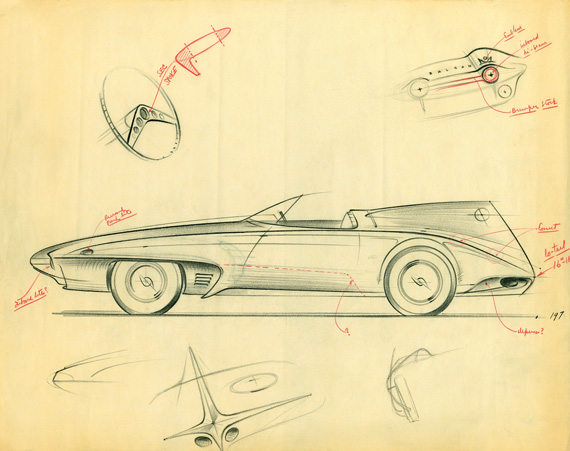
By 1959, the Falcon had evolved into the XNR. This is the first sketch; the car was later produced as the Plymouth XNR 500 in 1960, built by Ghia.
As a stylist, Exner stood head and shoulders above these two men. My belief is that Exner was unique in a few ways: he did the design work himself, and he worked with the designers as his peers, not as an autocrat or bully. He had his own private studio with his own clay modeler and worked tirelessly, night, day, and weekends at drawing, painting, and sculpture. He disliked paperwork and had little business or administration acumen. As a manager, he was a naturally amiable person, down to earth, quietly spoken. He was careful to spread the success of the 1957 model line (perhaps unprecedented in successfully offering an entirely new product for all 5 divisions of a major manufacturer) throughout his team. A somewhat shy person, he was nonetheless a public speaker for Chrysler, speaking in advertising campaigns and even serving as President of the Society of Automotive Engineers, often speaking at meetings and giving presentations. He was under tremendous pressure, as Chrysler was significantly behind Ford and GM when he started and needed a financial turnaround. He had 18 months to design the entire 1955 range; he had the weight of the world on his shoulders, for many reasons, not the least of which was that at the time Chrysler was run by engineers for engineers, who took a dim view of styling. He made it work, and at age 44 he became the first Director of Styling for Chrysler.
To learn the whole story, I recommend that you buy the book. It is a good story. In the meantime, I have chosen some pictures from the book that focus on his work with Ghia. There is a lot more besides this, of course, but you will have to read the book to find out about all that.
I remember Virgil Exner very well from when I was a child and he would come for dinner at my parent’s House in Via Vico in Torino as my father was Direttore Tecnico, Progettazzione Automobili at GHIA. There is a trend, almost a desire, to credit to Exner the styling that was so distinctive of GHIA concept cars but it was the other way around. He would never have claimed the credit for my father’s designs : they did collaborate and had too much respect for each other for it to be any other way. I did ask my mother once if he was Santa Clause, because Exner had a full head of snow white hair!!!
Alberta Savonuzzi
Fantastic review, Brandy! I know that you have spent a lifetime on this study. And how great to have Signora Savonuzzi comment on it!
Well, who REALLY designed the Buick le Sabre?
Congratulations on the good review. I regret that, as a lad in Detroit, I peeked through the windows of his studio hoping to see a new design but never knocked on the door to meet him. But a coupla questions–shouldn’t he have stomped off when Chrysler refused to put any one of his designs bodied in Italy into production, or was he cynical enough to know that none of them could make it from the drawing board to production unscathed?
Secondly, I gather he drove prototypes around as his “own” cars like Harley Earl, and later Bill Mitchell–was he the boldest among Detroit design chiefs in this respect?
Brandy
I am amazed at the amount of detail in your recall of Exners career. That your mind can store this much detail and the also the work you do that your daily tasks require
is astounding. I am tempted to try to go to SF and visit your collection.
Roy